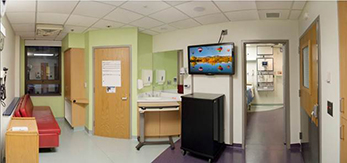 ATLANTA — Last November, Birmingham, Ala.-headquartered Brasfield & Gorrie completed the new metaiodobenzylguanidine (MIBG) radiation therapy room at the Aflac Cancer Center of Children’s Heathcare of Atlanta at Egleston. One of only eight in the nation, the facility will give patients located in the southeast access to more opportunities in terms of patient care.
ATLANTA — Last November, Birmingham, Ala.-headquartered Brasfield & Gorrie completed the new metaiodobenzylguanidine (MIBG) radiation therapy room at the Aflac Cancer Center of Children’s Heathcare of Atlanta at Egleston. One of only eight in the nation, the facility will give patients located in the southeast access to more opportunities in terms of patient care.
The MIBG treatment targets cancer cells directly and avoids collateral damage to other parts of the body that can occur during traditional therapy. Because of the high volume of radiation transmitted during the procedure, the patient is isolated from his or her family and friends during treatment, which can add anxiety and stress to the situation.
Brassfield & Gorrie based their design for the therapy room around this situation and gathered feedback from Erin and Stephen Chance, who had a son that was a patient at Children’s Healthcare of Atlanta. Previously, he had to travel to Children’s Healthcare of Philadelphia for these treatments because that was the nearest MIBG facility. The Chances worked with the construction team to develop a new design to make the experience more bearable. Televisions are included in each room, as well as three-way video and microphones, so the patient can see their family, talk to them and even play video games with them through the monitors.
Healthcare Construction + Operations News spoke with Tom D’Aleo, project manager at Brasfield & Gorrie, about the patient feedback and the experience designing for this new kind of patient experience.
Q: What kind of questions do you have to ask to get patient feedback that can then be incorporated into a design?
D’Aleo: Throughout the project the number one question was in regards to what can be done to make these two rooms — the parent and patient room — as comfortable as possible because both the patient and parent will be in the rooms for several days.
Q: What other aspects of design did you have to consider in terms of considering the patient experience for this project?
D’Aleo: HKS was the architect on this project and they were great to have on the team because this project was one that evolved throughout the construction process. One item that was taken into account during the planning stages of this project was how to create two adjoining rooms similar to a hotel room due to the fact that there was not enough space to have an anti-room. We used the existing patient room adjacent to the MIBG room as an “ante-room” and the parents’ room because during this treatment process the parent will be the person interacting most with the patient. During the treatment the patient emits radiation and others can only have limited exposure. We installed a lead-lined door between the parent room and MIBG room similar to what you see in adjoining hotel rooms.
Q: What was the biggest challenge on the project and how did you overcome those challenges?
D’Aleo: Space limitations were probably the biggest challenge because we had to work within the footprint of two existing patient rooms and convert one to an MIBG room and the other into an “ante-room” or parent room.
Q: Do you have any other pieces of advice for a professional designing a facility based on the patient experience?
D’Aleo: During the treatment, there are lead shields that need to be rolled into the room and placed in front of the doors, because the walls were lined with ¼-inch lead and the doors were only 1/16-inch lead. While this room is not being used for treatment, the heavy lead shields need to be stored somewhere, so having a storage closet nearby to store these shields and radioactive waste is something that needs to be considered. This is sometimes very hard to do while renovating due to space limitations.

